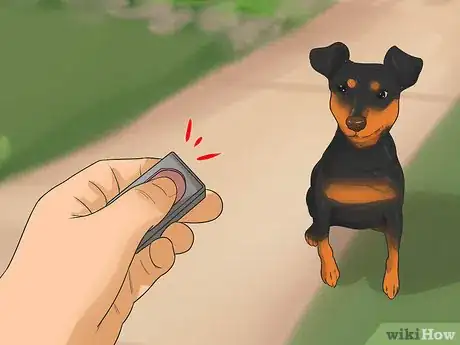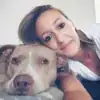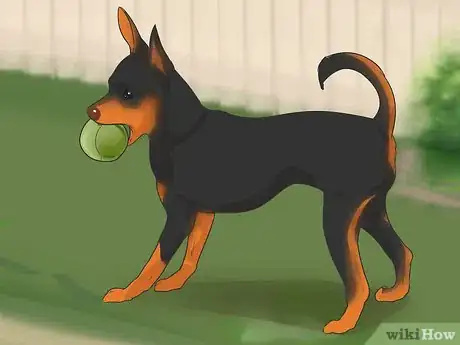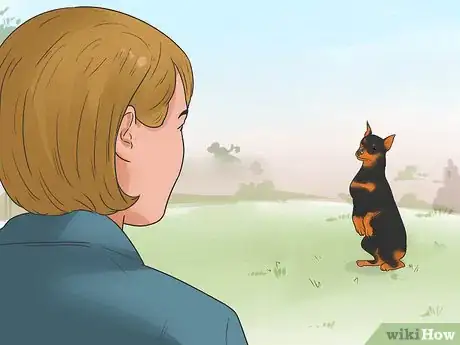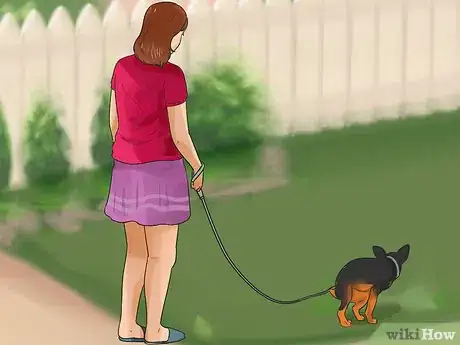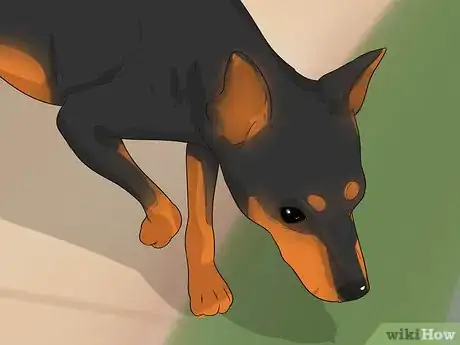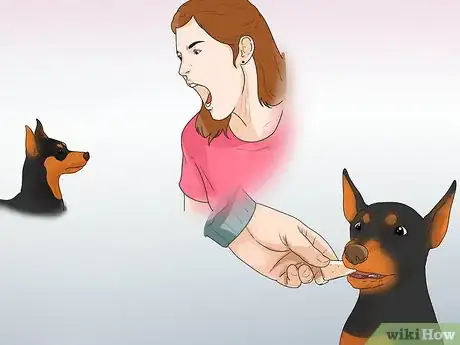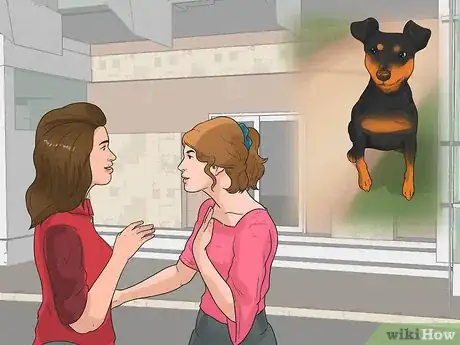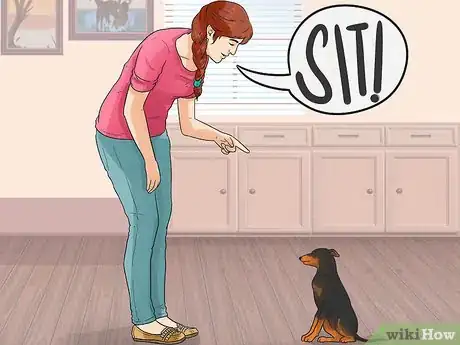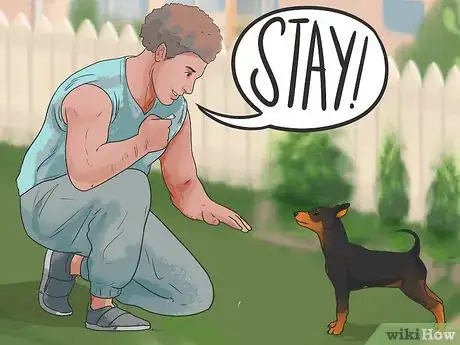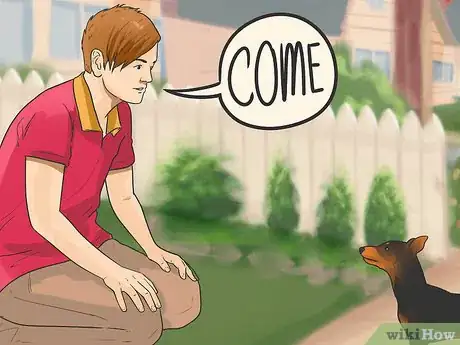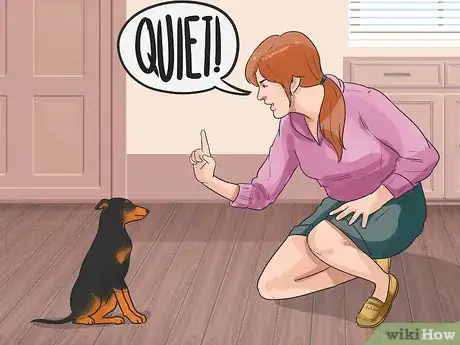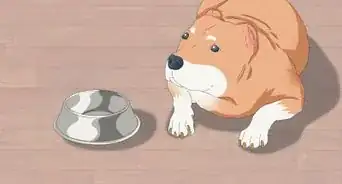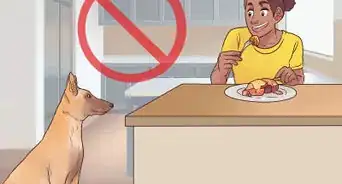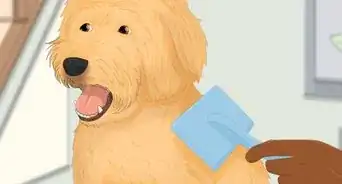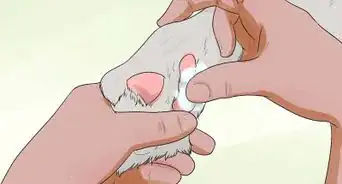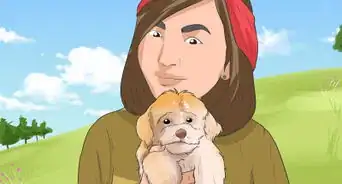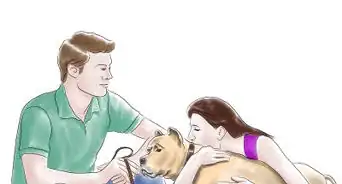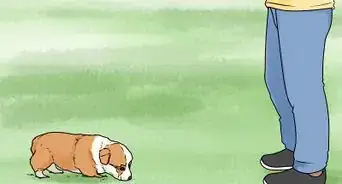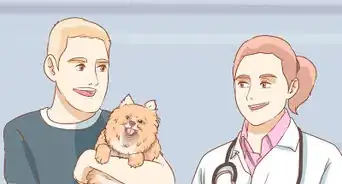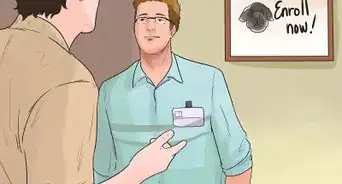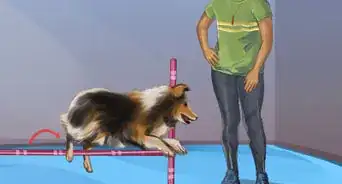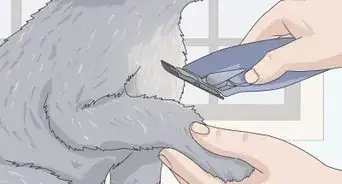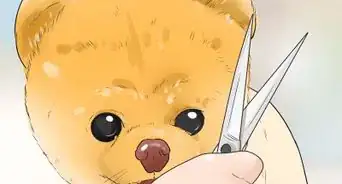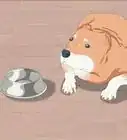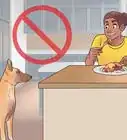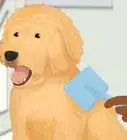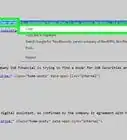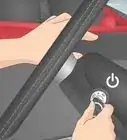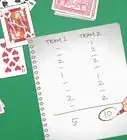This article was co-authored by Jessica Powell. Jessica is a Certified Professional Dog Trainer and the Owner of Proud Paws Dog Training, a small business offering private coaching and in-home dog training services to dog parents across the San Fernando Valley of Los Angeles, California. With nearly ten years of experience, she has extensive knowledge and experience in dog behavior, effective communication techniques, animal welfare, manners training, behavioral modification, and enrichment. Jessica holds a Bachelor of Science degree in Animal Management and is also an experienced shelter professional.
There are 10 references cited in this article, which can be found at the bottom of the page.
This article has been viewed 43,586 times.
Miniature pinschers, also known as mini pins, are small dogs with lots of spirit and attentiveness.[1] If you have recently chosen a mini pin as a new companion or if you have had a mini pin for a while, then you might be wondering about how you can train your mini pin. You can use dog training techniques to ensure that your mini pin is house trained and that he knows basic commands.
Steps
Using Helpful Training Techniques
-
1Get a clicker. It is important to mark your dog’s good behavior right when she does it. Using a clicker can help you to do this.[2] A clicker is a small noisemaker that you can buy in a pet supply store. Use a clicker to mark your dog’s good behavior and help her to learn what you want her to do.[3]
- For example, if your dog responds to your “Sit” command by sitting, then click the clicker right as her bottom hits the floor. This will help her to associate sitting with doing something good.
-
2Keep treats on hand.[4] Treats are excellent for motivating your mini pin to obey your commands. Keep a bag of your mini pin’s favorite treats on hand and reward her with one for following your commands.[5]
- Never hold treats in your hand while you are training. This will distract your dog and she will not be able to give you her full attention.[6]
- Try to vary how often you give your mini pin a treat. Giving a treat after every command can leave your mini pin expecting to be rewarded. Give frequent treats at first and then start to space them out more, such as every other command or every third or fourth command.
Advertisement -
3
-
4Train in different locations and positions. If you always train your mini pin while you are sitting down, then she may associate the command with your body position. Likewise, if you only train your mini pin in the living room, then she may associate the command with the room.[9]
- Make sure that you vary your training positions and locations to ensure that your mini pin will respond to your commands in any situation.
Housetraining Your Mini Pin
-
1Take your mini pin outside often. Potty training your mini pin takes time and effort on your part and hers. One important part of potty training is taking your mini pin outside to go potty often. You may need to take your mini pin out once every two hours until she is house trained.
- Make sure that you take her to the same spot every time. Choose a patch of grass in the yard where you want your mini pin to go potty and lead her to the same spot every time.
- Give her lots of praise when she goes potty outside. Rub her belly, say “Good dog!” and give her a treat when you get back in the house.[10]
-
2Watch for bathroom behaviors. Your mini pin will probably start showing some typical bathroom behaviors when she has to go potty, so be on the watch for these. Take her outside to go potty as soon as you notice bathroom behaviors. Some typical bathroom behaviors include:[11]
- sniffing
- walking in circles
- walking with back legs straight and stiff
-
3Use positive reinforcement, not negative reinforcement.[12] Always remember to reward your mini pin for going potty outside. Do not use negative reinforcement because it does not help your dog to learn new behaviors.[13] It only frightens your dog.[14]
- Never yell at your dog, hit your dog, or rub your dog’s nose in urine or feces. If your mini pin goes potty in the house, simply take your dog outside and clean up the mess right away to prevent her from using the same spot again.
- You can also clap your hands loudly if you notice her going in the house. This should startle her enough to get her to stop and then you can lead her outside to finish.[15]
-
4Enlist the help of a neighbor or friend during long periods away. If you will be at work or somewhere else for a long stretch of time, then it is important to find someone who can take your mini pin outside to go potty.
- Try asking a friend or neighbor to stop by once or twice to let out your mini pin or walk her around the block. If you cannot find someone to let your mini pin during the day, then consider hiring a dog walker or taking your mini pin to doggy daycare while you are away.
- Your dog cannot hold her urine or feces all day and it is cruel to expect your dog to do so. If you leave for a long stretch of time and your dog cannot go out, then she will likely have an accident.
Teaching Basic Commands
-
1Start with “Sit.” Sit is the most basic command that you can teach your dog and it is easy to teach, so it is a great place to start. To teach your dog to sit, stand in front of her and say “Sit” while raising your hand in the air or holding a treat in the air to keep her attention.[16]
- You may have to do this a few times before she gets the idea. If it does not work the first time, keep trying.
- If your mini pin does not respond to the command and hand gesture alone, then you can also try gently pushing her bottom down towards the floor while saying “Sit.”
-
2Teach your mini pin to “Stay.” Teaching the “Stay” command is also important in early training. To teach your mini pin to stay, wait until he is sitting down and then label the behavior as “Stay.” Reward your mini pin with praise and a treat for staying seated.
- After doing this few times, try giving the command while slowly backing away from your mini pin. Reward her if she stays put. Over time, your mini pin will learn that “Stay” means don’t move.
- You can also train this command while your mini pin is on a leash and just back away as far as the leash will allow.[17]
-
3Use the “Come” command to get your mini pinscher to walk towards you. Training your mini pin to come towards you is another important basic command. To train this command, say “Come” and pat your legs with your hands. This should entice your mini pin to walk towards you. If she does, then reward the behavior.
- After a few times of saying “Come” while patting your legs, you can progress to just giving the command. Say “Come” and see if your mini pin approaches you. If she does, reward her with a treat and lots of praise.
- If your dog does not respond to you standing up and patting your legs, you can also try squatting down with your arms out to her.[18] This might be a more comforting position for a puppy.
-
4Get your mini pin to “Speak.” Teaching you mini pin to speak is a fun basic command. You can teach this command by first doing something to get your mini pin to speak, such as knocking at the door. Then, while your mini pin is barking, label the behavior as “Speak” and reward her.[19]
- Repeat this exercise a few times and then try to get your mini pin to speak without knocking at the door. Just say “Speak” and see if your mini pin barks. If she does, then reward her with some praise and treat.
-
5Add the “Quiet” command. You can also train the “Quiet” command along with the “Speak” command. To train your mini pinscher to be quiet, wait until he stops barking on his own and then label the behavior by saying “Quiet.” Make sure to reward your mini pin for being quiet as well.[20]
- After labeling the behavior a few times, try to command your mini pin to be quiet while he is barking. Reward your mini pin if she goes quiet in response to your command.
Expert Q&A
-
QuestionAre mini pinschers easy to train?
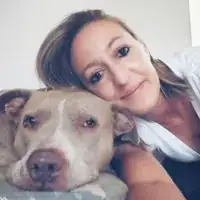 Jessica PowellJessica is a Certified Professional Dog Trainer and the Owner of Proud Paws Dog Training, a small business offering private coaching and in-home dog training services to dog parents across the San Fernando Valley of Los Angeles, California. With nearly ten years of experience, she has extensive knowledge and experience in dog behavior, effective communication techniques, animal welfare, manners training, behavioral modification, and enrichment. Jessica holds a Bachelor of Science degree in Animal Management and is also an experienced shelter professional.
Jessica PowellJessica is a Certified Professional Dog Trainer and the Owner of Proud Paws Dog Training, a small business offering private coaching and in-home dog training services to dog parents across the San Fernando Valley of Los Angeles, California. With nearly ten years of experience, she has extensive knowledge and experience in dog behavior, effective communication techniques, animal welfare, manners training, behavioral modification, and enrichment. Jessica holds a Bachelor of Science degree in Animal Management and is also an experienced shelter professional.
Certified Professional Dog Trainer Try not to let breed labels get in the way of your training goals and concentrate on your dog’s individual personality and pace of learning. Tapping into a dog’s breed history, however, can help you understand many of their natural behavioral choices and tendencies. For example, miniature pinschers were bred to hunt small mammals and giving them working enrichment activities can be a valuable part of preventing inappropriate behaviors and keeping them fulfilled.
Try not to let breed labels get in the way of your training goals and concentrate on your dog’s individual personality and pace of learning. Tapping into a dog’s breed history, however, can help you understand many of their natural behavioral choices and tendencies. For example, miniature pinschers were bred to hunt small mammals and giving them working enrichment activities can be a valuable part of preventing inappropriate behaviors and keeping them fulfilled. -
QuestionDo different dog breeds train differently?
 Jessica PowellJessica is a Certified Professional Dog Trainer and the Owner of Proud Paws Dog Training, a small business offering private coaching and in-home dog training services to dog parents across the San Fernando Valley of Los Angeles, California. With nearly ten years of experience, she has extensive knowledge and experience in dog behavior, effective communication techniques, animal welfare, manners training, behavioral modification, and enrichment. Jessica holds a Bachelor of Science degree in Animal Management and is also an experienced shelter professional.
Jessica PowellJessica is a Certified Professional Dog Trainer and the Owner of Proud Paws Dog Training, a small business offering private coaching and in-home dog training services to dog parents across the San Fernando Valley of Los Angeles, California. With nearly ten years of experience, she has extensive knowledge and experience in dog behavior, effective communication techniques, animal welfare, manners training, behavioral modification, and enrichment. Jessica holds a Bachelor of Science degree in Animal Management and is also an experienced shelter professional.
Certified Professional Dog Trainer Not so much, but many strong-willed breeds need a lot of exercise before they can focus, while some may appreciate their independence or be prone to becoming overstimulated. That said, the fundamental aspects of training are pretty much always the same: think about what your dog enjoys, what motivates them and what situations they do well in as a starting point.
Not so much, but many strong-willed breeds need a lot of exercise before they can focus, while some may appreciate their independence or be prone to becoming overstimulated. That said, the fundamental aspects of training are pretty much always the same: think about what your dog enjoys, what motivates them and what situations they do well in as a starting point. -
QuestionHow do you discipline a strong willed dog?
 Jessica PowellJessica is a Certified Professional Dog Trainer and the Owner of Proud Paws Dog Training, a small business offering private coaching and in-home dog training services to dog parents across the San Fernando Valley of Los Angeles, California. With nearly ten years of experience, she has extensive knowledge and experience in dog behavior, effective communication techniques, animal welfare, manners training, behavioral modification, and enrichment. Jessica holds a Bachelor of Science degree in Animal Management and is also an experienced shelter professional.
Jessica PowellJessica is a Certified Professional Dog Trainer and the Owner of Proud Paws Dog Training, a small business offering private coaching and in-home dog training services to dog parents across the San Fernando Valley of Los Angeles, California. With nearly ten years of experience, she has extensive knowledge and experience in dog behavior, effective communication techniques, animal welfare, manners training, behavioral modification, and enrichment. Jessica holds a Bachelor of Science degree in Animal Management and is also an experienced shelter professional.
Certified Professional Dog Trainer A dog with a strong will simply means we have to work a little harder and be more creative with how we train, what we use as rewards, or what kind of stimulation we provide them with to keep them engaged.
A dog with a strong will simply means we have to work a little harder and be more creative with how we train, what we use as rewards, or what kind of stimulation we provide them with to keep them engaged.
References
- ↑ http://www.akc.org/dog-breeds/miniature-pinscher/
- ↑ Jessica Powell. Certified Professional Dog Trainer. Expert Interview. 5 October 2021.
- ↑ http://www.humanesociety.org/animals/dogs/tips/teaching_basic_commands.html
- ↑ Ty Brown. Dog Trainer. Expert Interview. 4 June 2020.
- ↑ Jessica Powell. Certified Professional Dog Trainer. Expert Interview. 5 October 2021.
- ↑ http://www.humanesociety.org/animals/dogs/tips/teaching_basic_commands.html
- ↑ Jessica Powell. Certified Professional Dog Trainer. Expert Interview. 5 October 2021.
- ↑ http://www.humanesociety.org/animals/dogs/tips/teaching_basic_commands.html
- ↑ http://www.humanesociety.org/animals/dogs/tips/teaching_basic_commands.html
- ↑ http://www.aspca.org/news/house-training-your-dog-or-puppy
- ↑ http://www.aspca.org/news/house-training-your-dog-or-puppy
- ↑ Ty Brown. Dog Trainer. Expert Interview. 4 June 2020.
- ↑ Jessica Powell. Certified Professional Dog Trainer. Expert Interview. 5 October 2021.
- ↑ http://www.aspca.org/news/house-training-your-dog-or-puppy
- ↑ http://www.aspca.org/news/house-training-your-dog-or-puppy
- ↑ http://www.akc.org/learn/akc-training/teach-your-puppy-these-5-basic-commands/
- ↑ http://www.akc.org/learn/akc-training/teach-your-puppy-these-5-basic-commands/
- ↑ http://www.akc.org/learn/akc-training/teach-your-puppy-these-5-basic-commands/
- ↑ https://www.akc.org/expert-advice/training/train-your-dog-to-speak/
- ↑ http://www.humanesociety.org/animals/dogs/tips/how_to_stop_barking.html
About This Article
To train your miniature pinscher, use positive reinforcement to help it learn new commands and behaviors. For example, when your dog does something right, reward it with a belly rub, a new toy, or a trip to the park. You should also train it in different rooms and locations, so it doesn’t associate your commands with only one place. If your mini pinscher isn’t potty trained, take it outside every 2 hours or so until it learns to go outside. Make sure to reward it with praise and treats when it goes to the bathroom outside to encourage the behavior. For more tips, including how to teach your miniature pinscher to speak, read on!
